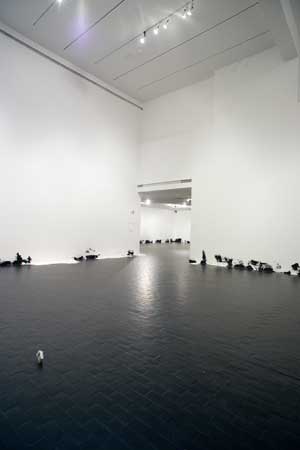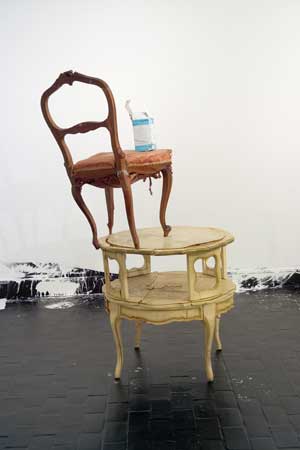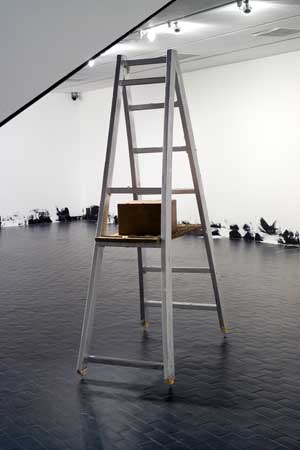At this year's melancholic Whitney Biennial, the work of Swiss artist Urs Fischer was the fourth floor crescendo. Against a theatrical backdrop of a blown-out wall, two rotating tree branches cast in aluminum were suspended from the ceiling. As they hovered above the floor, lit candles on either end deposited a trail of wax in two perfect overlapping circles. Mary Poppins, Fischer's current show at Blaffer Gallery, continues this coy and humorous play with funny movements and unlikely ephemeral material. Yet while Fischer's installation in New York relied on the drama of the cacophonous setting, in this exhibition the artist uses more subtle and irreverent deconstructive gestures.

Urs Fischer...Nach Jugendstiel kam Roccoko... 2006...Electrical motor, wires, carbon, elastic band, ...monofilament, empty cigarette pack... Radius 157 1/2 inches (400 cm); height variable...Courtesy Gavin Brown's Enterprise, New York
The show primarily consists of sparingly arranged sculptural assemblages of domestic objects that the artist animates with a sort of bad-boy humor. An empty pack of Camel cigarettes slowly skirts along the floor of one gallery. Attached by translucent thread to a mechanical device on the ceiling, the throwaway object seems possessed, trailing in a lethargic circle. Precariously stacked furniture defies gravity, a pencil jabbed into an egg is stuck to the wall, a ladder set on springs neurotically shakes, and a mouth-to-anus foam sculpture crudely springs from a gutted coffee table. The bizarre magic, which gives each sculptural vignette the unique personality of a dysfunctional family member, combined with the rather annoying inaccessibility of a dirty inside joke, follows the same of absurd logic of hiring a flying British nanny to fix a broken home.
These preposterous scenarios are reinforced by the artist's deceptive process. Fischer constructed the site-specific sculptures in only two weeks at the gallery. Polyurethane foam and plaster are expertly cast and carved to resemble banal beat-up stuff: a cheap ladder, a cardboard box, an egg shell. Addict is an assemblage of furniture that at the outset appears as a composition of found objects. An antique chair, with springs pushing out grimy upholstery foam, is balanced on two faux-rococo stacked end tables. After smashing the pieces, Fischer carefully spent four days reassembling the furniture. The broken and splintered bits, with glue oozing from the cracks in the fractured wood, are evident only upon close proximity.

Urs Fischer...Addict... 2006...Epoxy glue, found furniture...61 x 28 1/2 x 29 3/4 inches (155 x 72.5 x 73 cm)... Courtesy Gavin Brown's enterprise, New York...
Additionally, a complicated conversation between the works underscores Fischer's sculptural investigation of artistic process. Nothing is random in the installation, despite the seemingly ad-hoc aesthetic. He replicated the cardboard box that contained the plaster he used for the egg, for instance, on the ledge of the ladder. The plaster box, perched on the chair, was subjugated to the same violent restoration methods as the furniture, and the curved cabriole legs of the coffee tables served as the inspiration for the carved foam version in Untitled. The titles of the work further the thematic puns by snidely referencing art history. The quivering ladder, fashioned from beige foam and dull silver paint, is ironically called Chagall, as if the materials evoke the whimsical dreamscapes of the modern painter. Fischer named the haunted cigarette piece Nach Jugendstiel kam Roccoko. Looselytranslated from German as “After Art Nouveau came Rococo,” the anachronistic title reflects the backwards procedures that permeate the gallery. The most obvious example of this linear distortion if the stacked furniture of Addict. The pieces, kitschy appropriations of the 18th-century style, were literally made by being destroyed.
Fisher's perceptual game, or flirtation with a highly contrived irreverence, is most dramatic in the transformation of the gallery. A layer of black vinyl covers the Blaffer's normally earthy red brick floor and extends onto the walls. At the baseboards throughout the space, the rising black is countered by a sloppy attempt to cover it up with white paint. Some of the Pollock-like drips and splatters gush out on the floor. Shoe prints betray the urgency of execution, enhancing the slovenly clash between white and black. The muddled interaction, however, is disappointing. More like hip interior décor, it is not quite neat enough to read like a really bad paint job, and it fails to really explode into the space. I either wanted a subtle tension at the fringes of the white cube or a rebellious pleasure in the flair and drama of the performance. Moreover, for such a laborious effort to shift the experience of the gallery space, the wall effect should establish a coherent relationship with the work. For all of the exertion, it neither interferes nor distracts from the individual assemblages.

Urs Fischer...Chagall... 2006...Polyurethane, nails, enamel, acrylic, spackle, ...electrical motor, aluminum, battery, cables...89 1/2 x 41 x 24 inches (225 x 104 x 61 cm)... Courtesy Gavin Brown's Enterprise, New York
The sculptures also fit in this precarious position. They aren't quite found objects, but their interesting means of fabrication are veiled with such nonchalance that serious formal appreciation is negated (or rather, Fisher's work is hard to figure out because he positions his practice between careful craftsmanship and impromptu bravado). I guess I want more of one or the other. Devoting a gigantic gallery to an empty cigarette box, for instance, is an awesome and incredibly punk presentation in theory, but in person the expected visual punch is fairly anticlimactic.
During a round table discussion led by exhibition curator Claudia Schmuckli, Darryl Lauster distilled this ambiguity as an “unresolved mess.” While I hate to reduce the exhibition as a comment on the malaise of contemporary art, Lauster's succinct description is fitting. In fact, as Luca Buvoli pointed out that evening, Fischer's work could be an analogy for the crisis of sculpture. After abjection in the 1990, or Matthew Barney's baroque delight with gobs of Vasaline, Buvoli suggested that the work demonstrates what happens when materials no longer have the strength to communicate in what he defined as a “Post-shock” moment.
On the other hand, if Fischer's decisions are so strategic and witty, there is also something redemptive in their struggle for meaning. In a recent review of the work of Ted Riederer, an artist who also likes to smash and reassemble objects, Jerry Saltz expresses a new optimism. He argues that there is a desire in contemporary art to literally “put the pieces back together again.” Artists, he writes, are “trying to arrange the aftermath of a nilhistic, overeducated deconstruction into something — however awkward, simple, silly, or slight — that will play the song of art again.”[1] By hilariously and deliberately failing to distinguish between creation and destruction, perhaps Fisher offers a compelling conceptual challenge that can reaffirm faith in the creative act.
[1] Jerry Saltz, “Reconstruction Zone: An artist's quasi-religious, art-historical, life-and-death parable,” The Village Voice (June 12, 2006).
Images courtesy Blaffer Gallery and Gavin Brown's enterprise, NY.
Michelle White is a curtorial assistant at The Menil Collection.



